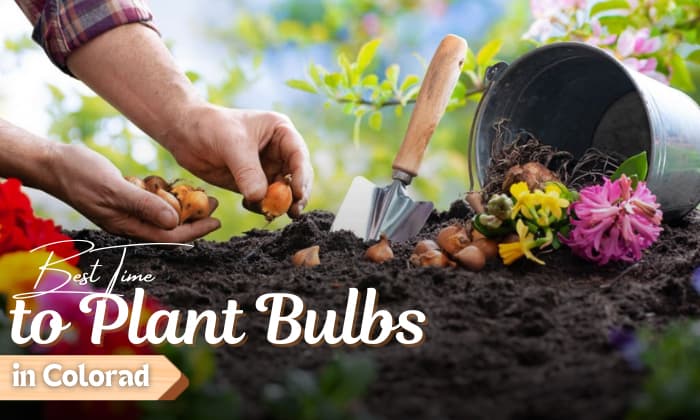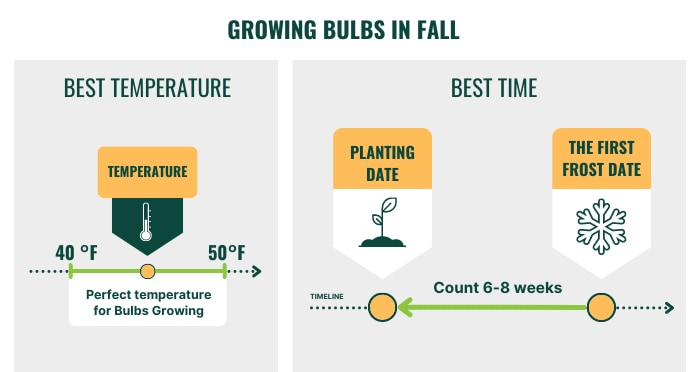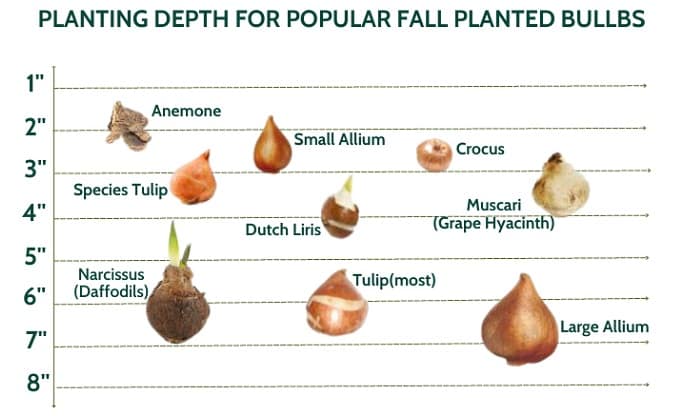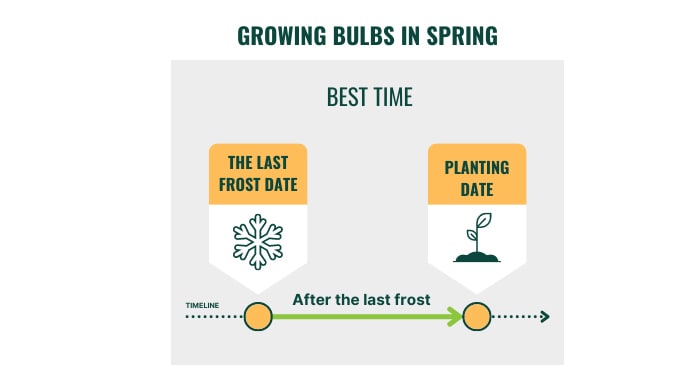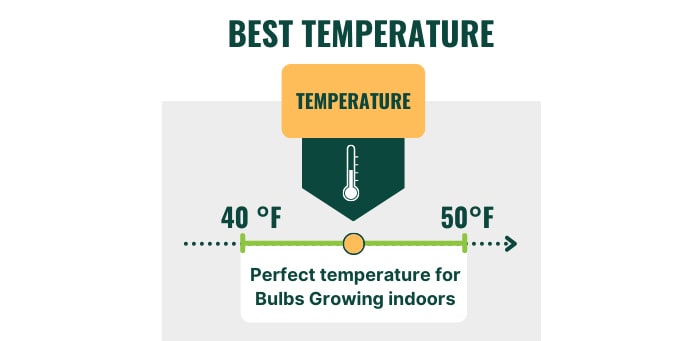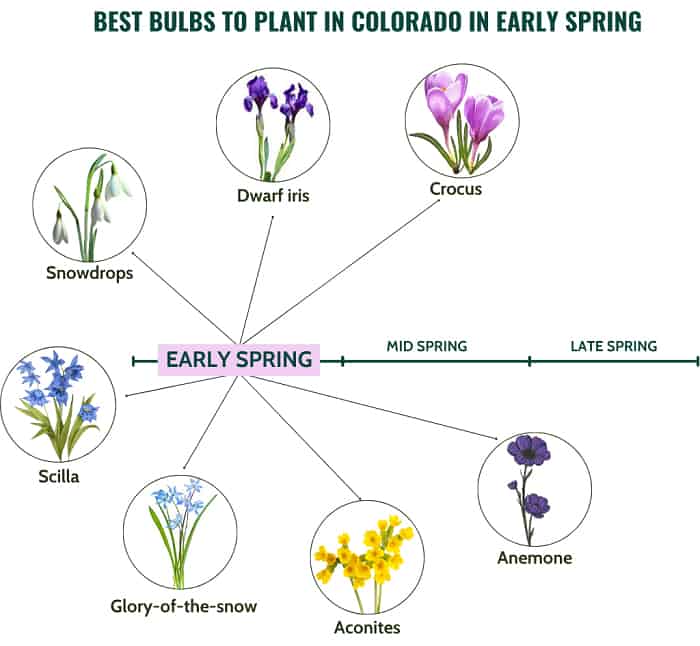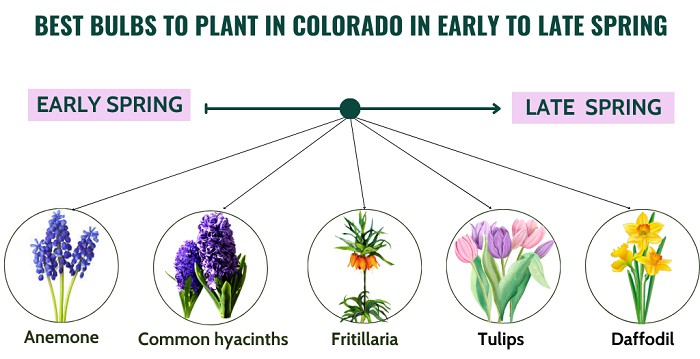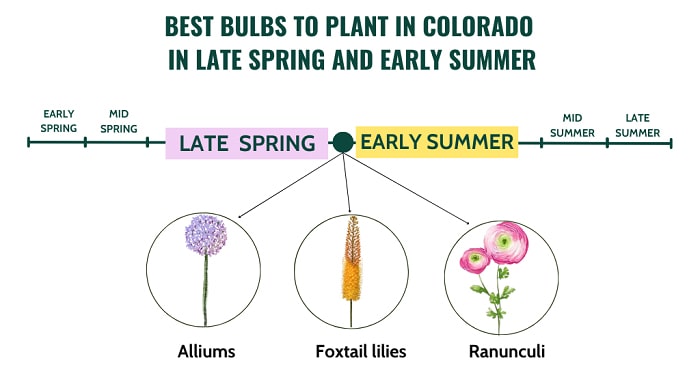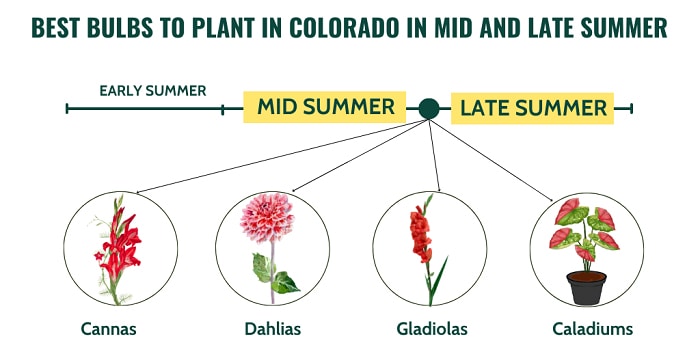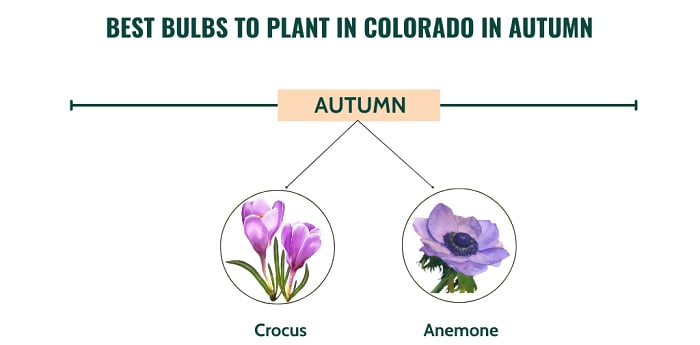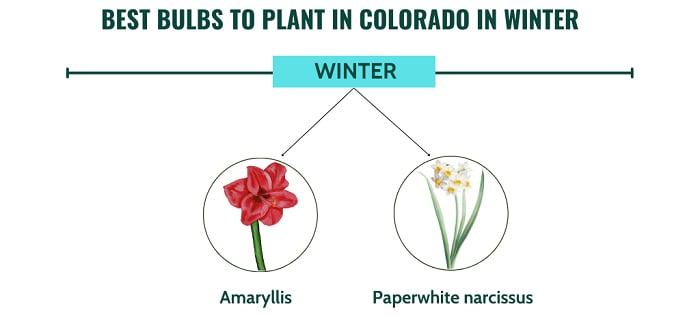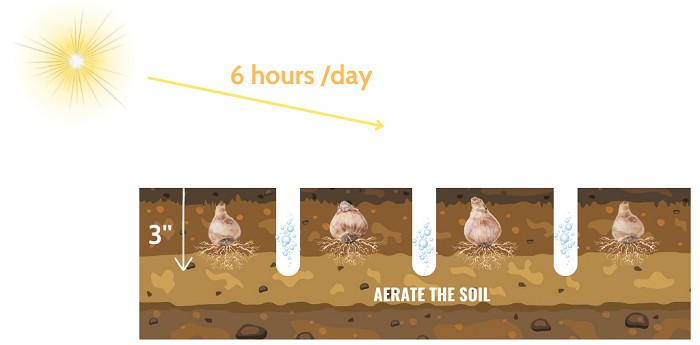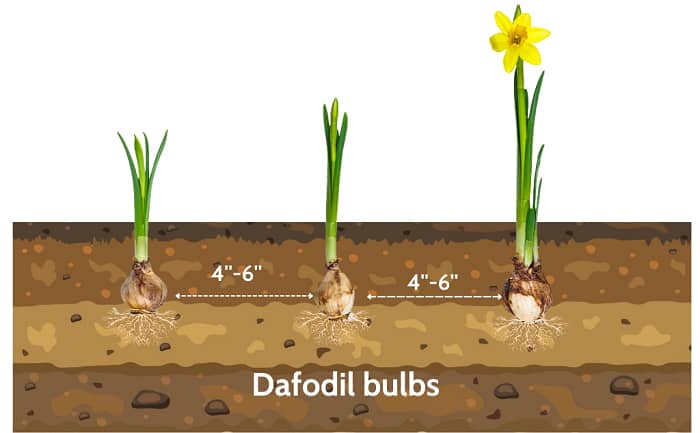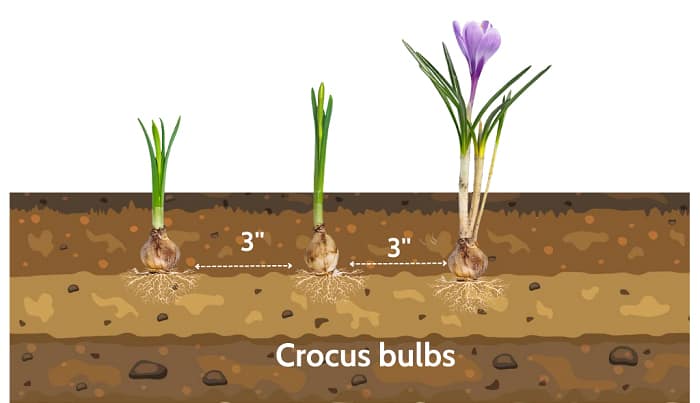Bulbs are easy to plant and available in a wide range of species, from daffodils and tulips to caladiums and dahlias. You only need to sow them at the right depth and cover them with soil, and they will shoot up after receiving adequate watering.
If you’re wondering when to plant bulbs in Colorado, growing them in the fall, around September and October, for spring flowering is the best option.
However, it’s also possible to start bulbs in the springs around mid-May; this schedule will lead to a blooming of summer bulbs that you can enjoy up until the first frost.
Other than that, the last and perhaps least popular option is forcing plants indoors around November for late winter and early spring blooms.
Table of Contents
Best Time to Plant Bulbs in Colorado
1. Plant in fall for spring blooms
Fall planting in Colorado should commence six weeks before the first frost if you want healthy spring blooms. With this time frame, the bulbs have enough days to establish themselves before winter comes, especially if you sow them under a temperature of 40 to 50℉.
As for bulbs to plant in fall in Colorado, check out tulips, hyacinths, snowdrops, fritillaries, crocus, alliums, snowflakes, and glory-of-the-snows.
To ensure your bulbs gardens thrive well, I recommend purchasing plants from stores in September, preferably at the beginning of the month, and growing them within the same month or during October. November gardening may not produce the best results, as it is too close to the first frost.
In the meantime, note that the sowing depth for bulbs should be three to four times their width. Below is a chart for some common plant types and their planting holes.
2. Plant in spring for summer and fall blooms
If you do not want to or forgot to plant fall bulbs, you can start gardening in the spring instead.
Simply plant bulbs in the spring in Colorado after the last frost. Choose caladiums, dahlias, begonias, gladioluses, cannas, lilies, eucomis, and tigridia for your garden, as all of these will do well with a spring sowing.
While growing bulbs under this category, expect them to blossom in summer or fall and die in winter. In other words, these plants are excellent options for an annual bulb if that’s what you’re after.
That said, it is also possible to keep your spring bulbs for more than one season if you cannot garden in the fall but want something a bit more long-lasting. Simply pick cold-hardy varieties, sow them in spring, and dig them up in winter before putting them back into the ground once spring comes.
Varieties with which you can do this include dahlias, which should be removed two weeks after the first frost, and cannas, which can only withstand a single freeze before storing them is necessary.
For all spring-planted varieties, hardy or otherwise, remember that the best time to plant bulbs is around mid-May, and you can order them in Colorado in mid-April.
For residents of colder areas, such as Colorado’s zone 4, it is ideal to plant lilies of the asiatic, trumpet, and oriental varieties. These flowers will survive winter outdoors here, so long as you protect them with grass clippings, composted leaves, or whatever organic mulch you have available.
If you live in zone 5 and 6, you don’t need to worry about these hardy plants dying at all, since the climate at these locations is warmer.
3. Force bulbs to bloom in winter or early spring
This method is preferable if you prefer to garden indoors and want flowers to decorate your home during winter. To “force” bulbs successfully, purchase plants made specifically for this purpose or look for those with a label saying “for indoor forcing.”
The best bulbs you can grow this way are amaryllis and paperwhite narcissus, since they do not require chilling before blooming. Other plants like hyacinths, crocus, and tulips will need to undergo cold temperatures to produce flowers.
So, if you plant hyacinth bulbs or tulip bulbs, you’ll need to keep them indoors under 35 to 38 degrees Fahrenheit. The winter outdoors in Colorado is too cold for them, so an unheated basement or fridge will be the best location.
Once the bulbs have been chilled in these places for twelve to sixteen weeks, they are ready to experience room temperatures and indirect sunlight and will bloom within three to four weeks.
As for amaryllis and paperwhite narcissus, you can go straight ahead to putting them in potting soil in November. Amaryllis will bloom in six to ten weeks, while paperwhite narcissus will take four to six weeks only.
Best Bulbs to Plant in Colorado
As a rule of thumb, the bigger the bulbs, the better. Whether you’re planting bulbs in fall or spring, opt for heavy, large, and plump ones to produce sizable, high-quality flowers. Avoid those with visible imperfections or decay, but beware that some bulbs will naturally be less pretty than others, so consider them exceptions to the rule.
Ranunculus and anemone bulbs will appear like claws, for instance, and it would be unrealistic to expect smooth, plump anemones or ranunculi for planting.
Looks aside, here are the best bulbs to grow in Colorado, sorted by their flowering time to help you plan for continuous blooms:
- Early spring – crocus, dwarf iris, snowdrops, scilla, glory-of-the-snow, aconites, anemone
- Early to late spring – grape and common hyacinths, fritillaria, tulips, daffodil
- Late spring and early summer – alliums, foxtail lilies, ranunculi
- Mid and late summer – cannas, dahlias, gladiolas, caladiums
- Autumn – crocus, anemone
- Winter – amaryllis, paperwhite narcissus
Where to Plant Bulbs?
Before you grow bulbs, pick a spot with six hours of full sun per day. The soil should be relatively loose and well-drained so that water doesn’t get trapped inside the planting holes and cause rot.
Equally as important are aeration and the lack of detritus, rocks, and grass in the garden plot. Airiness will improve if you incorporate sphagnum peat moss or compost into the soil at a rate of three inches or as much as necessary to replace a third of the soil.
Sometimes, though, you will need additional measures to improve the clay ground. For this type of medium, the best amendment would be peat, straw, or other fibrous materials tilled into the top six to eight inches of the planting location.
As for grass and other obstacles, you can use a herbicide to remove the former and get rid of the latter by hand.
Preparation-wise, it is best to check the requirements of the plant you’re growing. If you plant dafodil bulbs of the miniature varieties or plant tulips in Colorado, you’ll need to space them four to six inches apart, while crocus and glory-of-the-snow flowers only require three inches of distance.
Frequently Asked Questions
Is it too late to plant bulbs in Colorado?
November is often the latest time you can plant bulbs in Colorado. By the time December arrives, you’d be better off waiting until spring.
How late can I plant tulip bulbs in Colorado?
You can plant tulip bulbs in fall as late as November. I recommend looking up your first frost and counting backward six weeks to be sure.
Should I soak bulbs before planting?
Soaking bulbs before planting is unnecessary, but you can certainly dunk them in warm water for twelve hours and then sow them. This tip applies to both spring and fall-planted bulbs and will accelerate establishment.
What’s essential, though, is remembering to water bulbs after planting. Watering helps plants grow and improves aeration.
Conclusion
When to plant bulbs in Colorado is essential knowledge to creating a thriving garden with gorgeous blooms in spring, summer, and fall. So, decide which plant you want to grow and sow them according to our guidelines above. Soon enough, you’ll have a cluster of flowers that impress neighbors and passersby, even from afar.
Read more:

Hi, I am William – Floridayards’ digital content creator. My job is to find answers to all your concerns with thorough research and our team’s expert advice. I will also bring you honest reviews on the best products and equipment for raising your beautiful garden. Please look forward to our work!


